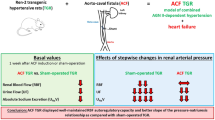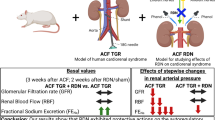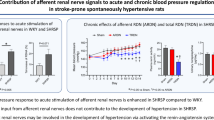Abstract
Recently, we demonstrated that chronic blockade of the renin−angiotensin system (RAS) lowered the blood pressure (BP) of adult Ren-2 transgenic rats (TGR) mainly through the attenuation of central sympathoexcitation. However, the participation of central and peripheral mechanisms in the development of high BP in immature TGR remains unclear. In the present study, 6-week-old heterozygous TGR males were chronically treated with intracerebroventricular (ICV) or intraperitoneal (IP) infusions of the AT1 receptor inhibitor losartan (1 or 2 mg/kg/day) for 4 weeks. The influence of these treatments on sympathetic- and angiotensin II-dependent BP components (BP response to pentolinium or captopril, respectively) as well as on BP response to exogenous angiotensin II were determined to evaluate the participation of central and peripheral RAS in hypertension development. Chronic IP losartan administration (1 or 2 mg/kg/day) lowered the BP of immature TGR by reducing both sympathetic and angiotensin II-dependent BP components. The central action of IP-administered losartan was indicated by a reduced BP response to acute ICV angiotensin II injection. Chronic ICV administration of a lower losartan dose (1 mg/kg/day) reduced only the sympathetic BP component, whereas a higher ICV administered dose (2 mg/kg/day) was required to influence the angiotensin II-dependent BP component. Accordingly, chronic ICV losartan administration of 2 mg/kg/day (but not 1 mg/kg/day) attenuated the BP response to acute intravenous angiotensin II application. In conclusion, central sympathoexcitation seems to play an important role in hypertension development in immature TGR. Central sympathoexcitation is highly susceptible to inhibition by low doses of RAS-blocking agents, whereas higher doses also affect peripheral angiotensin II-dependent vasoconstriction.
This is a preview of subscription content, access via your institution
Access options
Subscribe to this journal
Receive 12 print issues and online access
$259.00 per year
only $21.58 per issue
Buy this article
- Purchase on Springer Link
- Instant access to full article PDF
Prices may be subject to local taxes which are calculated during checkout





Similar content being viewed by others
References
Lee MA, Böhm M, Paul M, Bader M, Ganten U, Ganten D. Physiological characterization of the hypertensive transgenic rat TGR(mREN2)27. Am J Physiol. 1996;270:E919–29.
Brosnan MJ, Devlin AM, Clark JS, Mullins JJ, Dominiczak AF. Different effects of antihypertensive agents on cardiac and vascular hypertrophy in the transgenic rat line TGR(mRen2)27. Am J Hypertens. 1999;12:724–31.
Rakušan D, Kujal P, Kramer HJ, Husková Z, Vaňourková Z, Vernerová Z, et al. Persistent antihypertensive effect of aliskiren is accompanied by reduced proteinuria and normalization of glomerular area in Ren-2 transgenic rats. Am J Physiol Ren Physiol. 2010;299:F758–66.
Vaněčková I, Řezáčová L, Kuneš J, Zicha J. Moderate additive effects of endothelin receptor A blockade in Ren-2 transgenic rats subjected to various types of RAS blockade. Life Sci. 2016;159:127–34.
Vaněčková I, Dobešová Z, Kuneš J, Zicha J. The effects of repeated delivery of angiotensin II AT1 receptor antisense on distinct vasoactive systems in Ren-2 transgenic rats: young vs. adult animals. Hypertens Res. 2012;35:761–8.
Dampney RA, Polson JW, Potts PD, Hirooka Y, Horiuchi J. Functional organization of brain pathways subserving the baroreceptor reflex: studies in conscious animals using immediate early gene expression. Cell Mol Neurobiol. 2003;23:597–616.
Paton JF, Wang S, Polson JW, Kasparov S. Signalling across the blood brain barrier by angiotensin II: novel implications for neurogenic hypertension. J Mol Med. 2008;86:705–10.
Tsai CY, Poon YY, Chan JYH, Chan SHH. Baroreflex functionality in the eye of diffusion tensor imaging. J Physiol. 2019;597:41–55.
Dupont AG, Légat L. GABA is a mediator of brain AT1 and AT2 receptor-mediated blood pressure responses. Hypertens Res. 2020;43:995–1005.
Ito S, Sved AF. Blockade of angiotensin receptors in rat rostral ventrolateral medulla removes excitatory vasomotor tone. Am J Physiol. 1996;270:R1317–23.
Veerasingham SJ, Raizada MK. Brain renin-angiotensin system dysfunction in hypertension: recent advances and perspectives. Br J Pharm. 2003;139:191–202. https://doi.org/10.1038/sj.bjp.0705262
Muratani H, Averill DB, Ferrario CM. Effect of angiotensin II in ventrolateral medulla of spontaneously hypertensive rats. Am J Physiol. 1991;260:R977–84.
Muratani H, Ferrario CM, Averill DB. Ventrolateral medulla in spontaneously hypertensive rats: role of angiotensin II. Am J Physiol. 1993;264:R388–95.
Tsai CY, Su CH, Baudrie V, Laude D, Weng JC, Chang AY, et al. Visualizing oxidative stress-induced depression of cardiac vagal baroreflex by MRI/DTI in a mouse neurogenic hypertension model. Neuroimage. 2013;82:190–9.
Su CH, Tsai CY, Chang AY, Chan JY, Chan SH. MRI/DTI of the brain stem reveals reversible and irreversible disruption of the baroreflex neural circuits: clinical implications. Theranostics. 2016;6:837–48.
Lebrun CJ, Blume A, Herdegen T, Möllenhoff E, Unger T. Complex activation of inducible transcription factors in the brain of normotensive and spontaneously hypertensive rats following central angiotensin II administration. Regul Pept. 1996;66:19–23.
Chan JY, Chen WC, Lee HY, Chan SH. Elevated Fos expression in the nucleus tractus solitarii is associated with reduced baroreflex response in spontaneously hypertensive rats. Hypertension. 1998;32:939–44.
Chan JY, Wang LL, Lee HY, Chan SH. Augmented upregulation by c-fos of angiotensin subtype 1 receptor in nucleus tractus solitarii of spontaneously hypertensive rats. Hypertension. 2002;40:335–41.
Diz DI, Garcia-Espinosa MA, Gallagher PE, Ganten D, Ferrario CM, Averill DB. Angiotensin-(1-7) and baroreflex function in nucleus tractus solitarii of (mRen2)27 transgenic rats. J Cardiovasc Pharmacol. 2008;51:542–8.
Isa K, Arnold AC, Westwood BM, Chappell MC, Diz DI. Angiotensin-converting enzyme inhibition, but not AT1 receptor blockade, in the solitary tract nucleus improves baroreflex sensitivity in anesthetized transgenic hypertensive (mRen2)27 rats. Hypertens Res. 2011;34:1257–62.
Nautiyal M, Shaltout HA, de Lima DC, do Nascimento K, Chappell MC, Diz DI. Central angiotensin-(1-7) improves vagal function independent of blood pressure in hypertensive (mRen2)27 rats. Hypertension. 2012;60:1257–65.
Řezáčová L, Hojná S, Kopkan L, Rauchová H, Kadlecová M, Zicha J, et al. Role of angiotensin II in chronic blood pressure control of heterozygous Ren-2 transgenic rats: peripheral vasoconstriction versus central sympathoexcitation. Biomed Pharmacother. 2019;116:108996.
Berecek KH, Okuno T, Nagahama S, Oparil S. Altered vascular reactivity and baroreflex sensitivity induced by chronic central administration of captopril in the spontaneously hypertensive rat. Hypertension. 1983;5:689–700.
Berecek KH, Kirk KA, Nagahama S, Oparil S. Sympathetic function in spontaneously hypertensive rats after chronic administration of captopril. Am J Physiol. 1987;252:H796–806.
Wilson KM, Magargal W, Berecek KH. Long-term captopril treatment. Angiotensin II receptors and responses. Hypertension. 1988;11(Suppl I):I148–52.
Nishimura Y, Xu T, Jöhren O, Häuser W, Saavedra JM. The angiotensin AT1 receptor antagonist CV-11974 regulates cerebral blood flow and brain angiotensin AT1 receptor expression. Basic Res Cardiol. 1998;93(Suppl 2):63–8.
Leenen FH, Yuan B. Prevention of hypertension by irbesartan in Dahl S rats relates to central angiotensin II type 1 receptor blockade. Hypertension. 2001;37:981–4.
Zicha J, Kuneš J. Ontogenetic aspects of hypertension development: analysis in the rat. Physiol Rev. 1999;79:1227–82.
Dahl LK, Knudsen KD, Heine MA, Leitl GJ. Effects of chronic excess salt ingestion. Modification of experimental hypertension in the rat by variations in the diet. Circ Res. 1968;22:11–8.
Zicha J, Byšková E, Kuneš J, Pohlová I, Jelínek J. Sodium pump activity in young and adult salt hypertensive Dahl rats. Klin Wochenschr. 1987;65(Suppl 8):76–81.
Dobešová Z, Kuneš J, Zicha J. The altered balance between sympathetic nervous system and nitric oxide in salt hypertensive Dahl rats: ontogenetic and F2 hybrid studies. J Hypertens. 2002;20:945–55.
Heijnen BF, Peutz-Kootstra CJ, Mullins JJ, Janssen BJ, Struijker-Boudier HA. Transient renin-angiotensin system stimulation in an early stage of life causes sustained hypertension in rats. J Hypertens. 2011;29:2369–80.
Harrap SB, Van der Merwe WM, Griffin SA, Macpherson F, Lever AF. Brief angiotensin converting enzyme inhibitor treatment in young spontaneously hypertensive rats reduces blood pressure long-term. Hypertension. 1990;16:603–14.
Zicha J, Dobešová Z, Behuliak M, Pintérová M, Kuneš J, Vaněčková I. Nifedipine-sensitive blood pressure component in hypertensive models characterized by high activity of either sympathetic nervous system or renin-angiotensin system. Physiol Res. 2014;63:13–26.
Averill DB, Matsumura K, Ganten D, Ferrario CM. Role of area postrema in transgene hypertension. Hypertension. 1996;27:591–7.
Paxinos G, Watson C. The rat brain in stereotaxic coordinates. Burlington, MA: Elsevier Academic Press; 2005.
Minami N, Imai Y, Hashimoto J, Abe K. Contribution of vascular nitric oxide to basal blood pressure in conscious spontaneously hypertensive rats and normotensive Wistar Kyoto rats. Clin Sci. 1995;89:177–82.
Zicha J, Dobešová Z, Kuneš J. Late blood pressure reduction in SHR subjected to transient captopril treatment in youth: possible mechanisms. Physiol Res. 2008;57:495–8.
Behuliak M, Bencze M, Polgárová K, Kuneš J, Vaněčková I, Zicha J. Hemodynamic response to gabapentin in conscious spontaneously hypertensive rats. Hypertension. 2018;72:676–85.
Vavřínová A, Behuliak M, Bencze M, Vodička M, Ergang P, Vaněčková I, et al. Sympathectomy-induced blood pressure reduction in adult normotensive and hypertensive rats is counteracted by enhanced cardiovascular sensitivity to vasoconstrictors. Hypertens Res. 2019;42:1872–82.
Seltzer A, Bregonzio C, Armando I, Baiardi G, Saavedra JM. Oral administration of an AT1 receptor antagonist prevents the central effects of angiotensin II in spontaneously hypertensive rats. Brain Res. 2004;1028:9–18.
Kawano Y, Yoshida K, Matsuoka H, Omae T. Chronic effects of central and systemic administration of losartan on blood pressure and baroreceptor reflex in spontaneously hypertensive rats. Am J Hypertens. 1994;7:536–42.
Okuno T, Nagahama S, Lindheimer MD, Oparil S. Attenuation of the development of spontaneous hypertension in rats by chronic central administration of captopril. Hypertension. 1983;5:653–62.
Aileru AA, Logan E, Callahan M, Ferrario CM, Ganten D, Diz DI. Alterations in sympathetic ganglionic transmission in response to angiotensin II in (mRen2)27 transgenic rats. Hypertension. 2004;43:270–5.
Thybo NK, Korsgaard N, Mulvany MJ. Morphology and function of mesenteric resistance arteries in transgenic rats with low-renin hypertension. J Hypertens. 1992;10:1191–6.
Struijker-Boudier HA, van Essen H, Fazzi G, De Mey JG, Qiu HY, Lévy BI. Disproportional arterial hypertrophy in hypertensive mRen-2 transgenic rats. Hypertension. 1996;28:779–84.
Teisman AC, Pinto YM, Buikema H, Flesch M, Böhm M, Paul M, et al. Dissociation of blood pressure reduction from end-organ damage in TGR(mREN2)27 transgenic hypertensive rats. J Hypertens. 1998;16:1759–65.
Rossi GP, Cavallin M, Belloni AS, Mazzocchi G, Nussdorfer GG, Pessina AC, et al. Aortic smooth muscle cell phenotypic modulation and fibrillar collagen deposition in angiotensin II-dependent hypertension. Cardiovasc Res. 2002;55:178–89.
Ding J, Yu M, Jiang J, Luo Y, Zhang Q, Wang S, et al. Angiotensin II decreases endothelial nitric oxide synthase phosphorylation via AT1R Nox/ROS/PP2A pathway. Front Physiol. 2020;11:566410.
Arnet UA, Novosel D, Barton M, Noll G, Ganten D, Lüscher TF. Endothelial dysfunction in the aorta of transgenic rats harboring the mouse Ren-2 gene. Endothelium. 1999;6:175–84.
Dampney RA, Li YW, Hirooka Y, Potts P, Polson JW. Use of c-fos functional mapping to identify the central baroreceptor reflex pathway: advantages and limitations. Clin Exp Hypertens. 1995;17:197–208.
Lohmeier TE, Lohmeier JR, Warren S, May PJ, Cunningham JT. Sustained activation of the central baroreceptor pathway in angiotensin hypertension. Hypertension. 2002;39:550–6.
Acknowledgements
Technical assistance from Zdeňka Kopecká is highly appreciated. This study was supported by the Institute of Physiology, Czech Academy of Sciences (grant nr. RVO 67985823, IV) and by Joint Project of GACR and MOST, Taiwan (grant nr. 19-08260J, HR).
Author information
Authors and Affiliations
Corresponding author
Ethics declarations
Conflict of interest
The authors declare no competing interests.
Additional information
Publisher’s note Springer Nature remains neutral with regard to jurisdictional claims in published maps and institutional affiliations.
Rights and permissions
About this article
Cite this article
Řezáčová, L., Vaněčková, I., Hojná, S. et al. Both central sympathoexcitation and peripheral angiotensin II-dependent vasoconstriction contribute to hypertension development in immature heterozygous Ren-2 transgenic rats. Hypertens Res 45, 414–423 (2022). https://doi.org/10.1038/s41440-021-00775-2
Received:
Revised:
Accepted:
Published:
Issue Date:
DOI: https://doi.org/10.1038/s41440-021-00775-2



